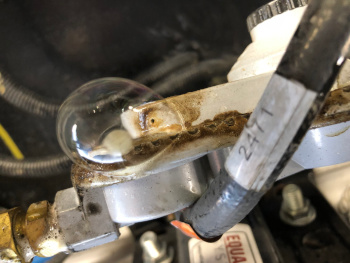This page complements the article written for the Escapees Club Magazine September/November 2018 issue on LP Gas Safety.
My family and I have used liquid propane (LP) gas for 60 years and, in our experience with its use, I feel it is safe. However, I know of others who have experienced unfortunate incidents due to lack of knowledge on LP gas care and use. Most of the problems were caused by overfilling the tank or using it in an incorrect manner.
The video on this page shares best practices on how to fill the propane tank properly and demonstrates how the liquid propane changes from a liquid to a gas for use by your appliances. In addition the video shows how to adjust the propane pressure to solve problems like a Dometic or Norcold fridge that will not cool when on LP gas, but cools properly when on shore power.
Click here for our Norcold LP Filter cleaning page.
This regulator was on a Leisure Travel Class-C. Apparently this is a known defective regulator because they tend to fail within a few years of purchasing the RV. The owner of this RV noticed that his LP Gas level was going down very fast without his using the propane. The owner noted that his tank had been over filled, thus it is possible that the liquid LP got into the regulator and blew out the diaphragm. Another possible cause for failure is oil in the regulator diaphragm, note the staining around the vent hole which is clearly leaking because of the soap bubble formed during a leak test.
The first fact is that all portable LP tanks are designed to be used and filled in the proper position. There are two basic types of tanks, vertical and horizontal. The vertical tank sits upright. An example is a typical 20-pound, 4.7-gallon tank used for a barbecue (please see LP Tank Filling Capacity Chart below). The tank in my Lance camper is a horizontal tank. (A rule of thumb is that a horizontal tank is longer from side-to-side when it is in the fill-and-use position.) There are only two correct ways to fill a propane tank. One is to read the permanent tag on the tank and use a conversion chart to fill it by its gross weight (see below). This requires the attendant to accurately read the tank tag, use a conversion chart properly and then use a calibrated scale correctly. In my opinion, this method can introduce error if the attendant is not careful. The second method is to use the tank bleeder valve connected to the bleeder valve liquid level tube. Assuming the attendant follows the proper order of operations, this is the simplest way to fill a tank, the video above demonstrates this method.
The chart below is used when filling a propane tank by weight.
It converts water capacity (W.C.) to pounds of propane that the
attendant can use to fill the bottle.
EXAMPLE: TANK TAG INFO:
If the tank is stamped W.C. = 47.8, the tank has a capacity of 20
Pounds of propane according to the chart below. The tank will also
be stamped with the empty weight of the bottle, which is called the
tare weight (TW). If TW = 18, then [Pounds of Propane + TW] = [20 +
18] = 38 pounds total weight of the tank and propane when filled.
W.C. = Water Capacity
GAL. PROPANE = LBS. PROPANE ÷ 4.11 (LBS./GAL.),
Where 4.11 (LBS./GAL.) is the density @ 25°C (77°F),
it must be noted that propane expands at ~1.5% per 10°F,
thus it is critical to know the temperature of the propane to know the exact gallons.
| W.C. | LBS. PROPANE | GAL. PROPANE | W.C. | LBS. PROPANE | GAL. PROPANE |
|---|---|---|---|---|---|
| 2.39 | 1 | 0.24 | 35.8 | 15 | 3.65 |
| 4.78 | 2 | 0.49 | 38.2 | 16 | 3.86 |
| 7.17 | 3 | 0.73 | 40.6 | 17 | 4.14 |
| 9.56 | 4 | 0.97 | 43.0 | 18 | 4.38 |
| 11.9 | 5 | 1.22 | 45.4 | 19 | 4.62 |
| 14.3 | 6 | 1.46 | 47.8 | 20 | 4.87 |
| 16.7 | 7 | 1.70 | 59.7 | 25 | 6.08 |
| 19.1 | 8 | 1.95 | 71.7 | 30 | 7.30 |
| 21.5 | 9 | 2.19 | 78.8 | 33 | 8.03 |
| 23.9 | 10 | 2.43 | 83.6 | 35 | 8.52 |
| 26.2 | 11 | 2.68 | 95.6 | 40 | 9.73 |
| 28.6 | 12 | 2.92 | 105.1 | 44 | 10.71 |
| 31.0 | 13 | 3.16 | 119.5 | 50 | 12.17 |
| 33.4 | 14 | 3.41 | 239 | 100 | 24.33 |